We are on the Waters Muddy: Taking Memphis Aboard the U.S.S. Benton
Moses Farnsworth, a former infantryman with the 15th Illinois, joined the crew of the ironclad gunboat U.S.S. Benton in the spring of 1862 as part of the deck force. What he saw in the aftermath of the Battle of Memphis underscores that service in the brown water Navy was just as bloody as fighting upon land.
Describing the C.S.S. Beauregard, he wrote "the steam from the boilers scalded four poor firemen in a most shocking manner. One who went on board immediately after the fight says the spectacle afforded by these sufferers exceeded anything he ever saw before and was enough to tear the most unfeeling heart. They implored him to give them relief, but all the relief which could be afforded was produced by the application of flour, sprinkled very lightly upon them. So completely had the steam penetrated the flesh that it hung in shreds upon their bones, the least touch or motion causing it to fall off entirely! As we passed her, she was sinking rapidly with steam escaping from all sides. I only saw one man aboard her; he sat on the stairs leading to the quarterdeck and forecastle begrimed with powder and apparently wounded. He had lost his cap and his appearance was sad and heart-rending in the extreme."
Three letters written by Farnsworth, serving as sergeant in charge of infantry forces aboard the U.S.S. Benton, appeared in the June 14th and June 21, 1862, editions of the Weekly Waukegan Gazette.
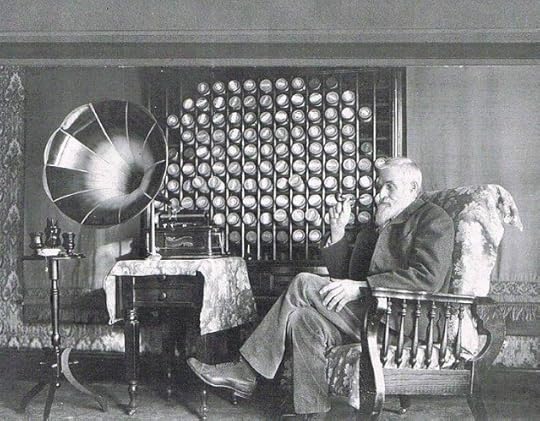 Moses Farnsworth of the U.S.S. Benton sits besides his turn of the century Edison phonograph. The wall of cylinders behind him were played upon the phonograph and each cylinder had about four minutes worth of music. One wonders if Farnsworth enjoyed listening to patriotic airs, classical music, or even ragtime! Farnsworth joined the Benton from the ranks of Co. I of the 15th Illinois early in 1862 and remained with the vessel for the remainder of his three-year term of service. Among his comrades from Co. I who joined the brown water navy included Corporal Walter Muir aboard the Illinois, Ephraim Hawthorn aboard the Cincinnati, and Edwin Crane who served as ship's cook aboard the Benton. A native of Vermont, Farnsworth moved to Waukegan, Illinois in 1853 with his parents, joining the 15th Illinois in the summer of 1861. Farnsworth lived until 1933, passing away at age 94 in Kansas, the father of 13 children who at the time of his decease had 28 grandchildren and 17 great-grandchildren living!
Moses Farnsworth of the U.S.S. Benton sits besides his turn of the century Edison phonograph. The wall of cylinders behind him were played upon the phonograph and each cylinder had about four minutes worth of music. One wonders if Farnsworth enjoyed listening to patriotic airs, classical music, or even ragtime! Farnsworth joined the Benton from the ranks of Co. I of the 15th Illinois early in 1862 and remained with the vessel for the remainder of his three-year term of service. Among his comrades from Co. I who joined the brown water navy included Corporal Walter Muir aboard the Illinois, Ephraim Hawthorn aboard the Cincinnati, and Edwin Crane who served as ship's cook aboard the Benton. A native of Vermont, Farnsworth moved to Waukegan, Illinois in 1853 with his parents, joining the 15th Illinois in the summer of 1861. Farnsworth lived until 1933, passing away at age 94 in Kansas, the father of 13 children who at the time of his decease had 28 grandchildren and 17 great-grandchildren living! Onboard the Benton,above Fort Pillow, Tennessee
June 1, 1862
We are not out on the ocean blue butare on the waters muddy and space to us as impassable as the oceans intervenesbetween us and home. Mementoes from friends at the fireside awaken emotions inour bosoms which those who have never been in circumstances with ourselvescannot realize.
I wrote you in my last letter thatappearances indicated a speedy attack on Fort Pillow. These appearances are notindicative of an attack at present as they were then, but to be sure, a hunterbecomes more quiet and watchful the nearer he approaches his game. The boatsare busy getting their vulnerable parts better protected with railroad iron.The experience of May 10th [the Battle of Plum Point Bend, click here to read more] taught us that the Rebel fleet is not to be despised altogether.We whipped them soundly as it was, however, and would have done so morecompletely if they had stayed and fought it out.
We learn from deserters (who by theway are constantly arriving) that the Rebels are out of coal which forces themto use wood exclusively. We also hear that Farragut’s fleet was within 108 milesof Memphis several days ago and that the Rebels have fallen back to Jackson,Mississippi. But as both are rumors or “hammock dispatches” as we call them, weput little reliance in them.
The mortars on our side and the bigguns on the Rebels still continue their harmless practice of pitching shells ateach other. Harmless I say as I mean harmless on our side as we do not know theeffect of our shells upon the Rebels. We move a couple of mortars below us ahalf a mile or so every morning, protecting them by as many gunboats and thenbang away. They generally return shot for shot, which burst in the air somewherein the vicinity with a loud explosion, producing much smoke and noise but doingno damage.
The river is every day receding fromits banks and we can now see a line of sand and driftwood which by contrast ismore agreeable than the sluggish, eternally flowing water which was all wecould see before. Today we have had muster and the church service read whichhas been the second time since Commodore Foote went away. A fine breezeflutters the clean banners which are hoisted every Sunday morning. The fleetpresents quite a holiday appearance. It is also quite cool; made so by a fineshower we had last night.
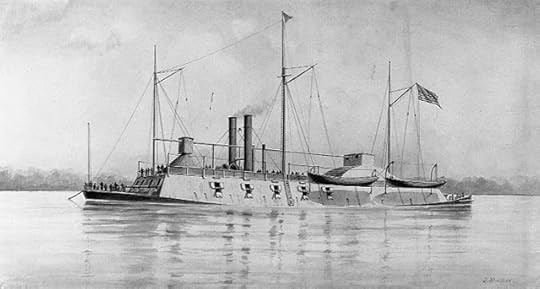 The U.S.S. Benton was commissioned into the U.S. Navy in February 1862 after being converted from a civilian-owned center wheel catamaran snagboat known as Submarine No. 7. The 633-ton vessel was 202 feet long and 72 feet abeam and carried 16 cannons, a mix of smoothbores and rifles.
The U.S.S. Benton was commissioned into the U.S. Navy in February 1862 after being converted from a civilian-owned center wheel catamaran snagboat known as Submarine No. 7. The 633-ton vessel was 202 feet long and 72 feet abeam and carried 16 cannons, a mix of smoothbores and rifles. On board theBenton, opposite Fort Pillow, Tennessee
June 5, 1862
Since writing my last, the fleet haschanged positions and we hope for the better. Fort Pillow has been evacuated bythe Rebels and is now in our possession. Why it came into our possessionwithout a fierce battle is undoubtedly owing to strategy, but not strategy emanatingfrom our flag officer, but the strategy of the generals commanding the landforces before Corinth. The evacuation of Corinth would isolate this point andrender it useless to the Rebels. On the other hand, with the enemy still inpossession of Corinth, reducing Fort Pillow and pushing on to Memphis wouldisolate our fleet in a measure and bring us no good. Hence, it appears that ourfleet before Fort Pillow was placed more to menace than reduce it, and our apparentinactivity was to say the least a masterly one and produced the exact resultswhich were desired.
Our boats were rapidly being shieldedin their weak parts by the application of railroad iron which would effectuallyprevent a reoccurrence of the scenes of May 10th. The fleet was alsoincreased by the arrival or six or more powerful rams. We expect within theweek to see the Essex, Cincinnati, and perhaps the Eastport whichrumor said was to be the flagship. Troops were being concentrated at this pointto cooperate with us whenever the flag officer should be ready to proceed tobusiness and what was more to the point, a mail had been sent on board forFarragut’s fleet to be delivered whenever convenient. Before we were all readyfor active hostilities, however, reliable news came of the evacuation ofCorinth.
Tuesday morning our cavalry captured aparty of 7 men who were in the act of taking ice from the icehouse located on aplantation near the fort. From these prisoners we learned that the fort was evacuatedthe night before, leaving only 18-20 men to keep up appearances. This somebelieved and others did not; but at all events, two rams went down the same dayto reconnoiter. The Rebels at once opened fire upon them and continued untilthey had fired 40 rounds or more. At this, the rams retired.
The same evening, two Rebel gunboatscame in sight around the point, but they soon fell back as the fire from theCairo and Mound City was too warm for them. We also prepared to go down to givethem a reception but through some delay we did not even start. The firing fromthe fort and the approach of the Rebel gunboats weakened belief in theprisoners’ story but as they still insisted on the truth of these statements,the flag officer prepared to go down at once and occupy the place.
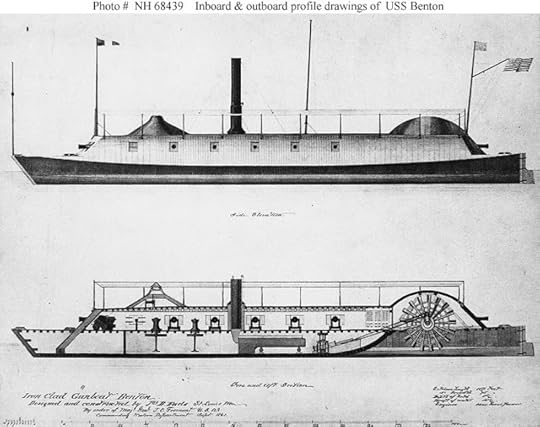 This drawing shows the interior of the Benton with the center wheel protected by an iron shell. As Farnsworth notes in his letter, additional railroad iron was added to the vessel in late May 1862 to provide extra armor protection, employing lessons learned at the Battle of Plum Point Bend.
This drawing shows the interior of the Benton with the center wheel protected by an iron shell. As Farnsworth notes in his letter, additional railroad iron was added to the vessel in late May 1862 to provide extra armor protection, employing lessons learned at the Battle of Plum Point Bend. On Wednesday, scouts from the landforces were sent to obtain as much information as possible of affairs going onin and around the fort. About sunset they returned and announced the complete evacuationof the fort, nothing being visible anywhere around. At the same time, smoke wasseen rising from the vicinity of the fort and a glow like flame tinted theclouds above, giving them a very beautiful appearance. We at once came to theconclusion that the Rebels had fired the place and this was verified when thetug Jessee returned with the information that everything which theRebels did not wish to take away such as wood, gun carriages, and barracks, wasin flames.
Early Thursday morning, we uppedanchor, signaled to the fleet to get under way, and steamed down to FortPillow. Two rams preceded us and upon our arrival we found the stars andstripes floating over the fort. Nothing was to be seen around the parapetsexcept here and there a dismounted gun which the Rebels had left burning intheir carriages. It is impossible to accurately describe the batteries. Theywere, for the most part, water batteries rising in height from the water’s edge.The battery on the extreme summit of the bluff may have been 70 feet above thelow water mark. The guns were generally 32-pounders but that had one123-pounder in a casemate. Reports are very conflicting in regard to the numberof guns mounted, but as near as I can get at the truth I judge there were about24 guns.
Chickasaw Bluffs upon which the fortis placed, the first of three ranges of high land between Cairo and Memphis,takes its name from the Chickasaw tribe of Indians who held possession of thisregion of the Mississippi when Memphis was first commenced by the French as atrading post. The bluffs rise abruptly from the river 100 feet or more and, incontrast to the low-level shore between this point and Memphis, present quite abold and picturesque appearance. Cool Creek discharges its waters into theMississippi at its base and has piled up quite a sand creek in the middle ofthe stream. The river at this point is very narrow, so narrow that to use asailor’s phrase, you can toss a biscuit across it. Altogether the place bynature is very strong and with batteries well mounted with guns of an improvedpattern and manned with determined and experienced crews, it would be almostimpregnable. As it was, a land force of 1,000 men cooperating with our fleetwould have reduced it in two hours.
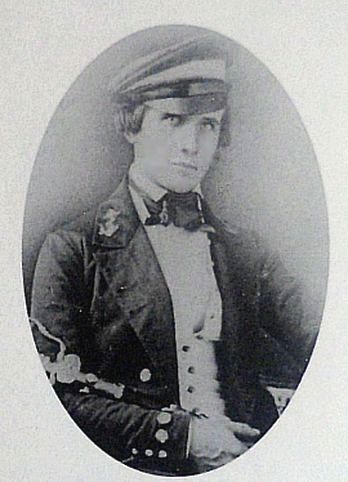 Lieutenant Seth Ledyard Phelps commanded the U.S.S. Benton during the naval battle of Memphis and later sent back the captured flag of the C.S.S. General Bragg to Governor David Tod of Ohio.
Lieutenant Seth Ledyard Phelps commanded the U.S.S. Benton during the naval battle of Memphis and later sent back the captured flag of the C.S.S. General Bragg to Governor David Tod of Ohio. On board theBenton, off Memphis, Tennessee
June 12,1862
The last time I wrote you we werebefore the fortifications of Fort Pillow. Since that time, however, events ofthe greatest interest and importance have transpired. I was fortunate to besomewhat a participator in those events. About 1 p.m. Thursday we turned our prowsdownstream and resumed our voyage to Memphis. Cultivation now began to bevisible at intervals and an occasional plantation with its rows of negro huts,some looking neat and pretty but more of them looking untidy and dilapidated.
The town of Randolph offered us nomolestation; indeed, the stars and stripes were already floating over almostthe only house in the place as we passed. Further down the river, the vandalismof the Rebels was seen in the cotton which was floating in the stream orburning upon the shore. Quantities of it had caught on the roots projectingfrom the shore and now lay in heaps on the banks where it had been placed bythe greedy.
At Island No. 37, we fell in with aRebel transport which we at once opened fire upon but, it being fleeter thanourselves, came very near escaping. Lieutenant Bishop saw the danger and by thepermission of the flag officer at once selected a few men, got upon the tug Spitfirewhich had mounted upon it a 12-pounder howitzer, and gave chase. A bend in thestream soon hid them from our sight, but it was not long before we heardseveral reports of the piece and we concluded the Spitfire hadoverhauled her. This proved correct for upon rounding the bend, the steamer wasseen run upon the shore with the tug alongside. The stars and stripes floatedover her and she proved to be the steamer Sovereign.
At about 9 p.m. we anchored a coupleof miles above in Memphis in plain view of the lights of the city and the Rebelfleet. Everything was silent as a grave, save an occasional puff-choo of aRebel transport of the whistle of an arriving or departing locomotive. To usthe scene partook of the romantic for Memphis, the furthest Thule of ourdreams, enveloped in the haze of twilight, lay before us.
"Our gunboats kept close down the left shore of the Tennessee side and as the Rebels crossed over to meet them, they left the right side on the Arkansas shore clear. Our rams were then signaled to run down the right shore and get in below or the rear of the Rebel fleet, and thus cut off their retreat. This was also accomplished in a very handsome manner." ~ Chief Engineer William G. McFarland, U.S.S. Cincinnati
The sky was cloudless on the morningof June 6, 1862, and the sun robing itself in the rainbows of the morning forthe 10,000th time, glanced lovingly down upon the lovely city.Nothing in nature betokened a storm or conflict. We eagerly paced the quarterdecksof our respective crafts, Union and Confederate, prepared for the dreadencounter about to take place. At 4:30 in the morning, the Rebel fleet, aftermaneuvering for some time seemingly undecided whether to fight or run, took aposition opposite the landing at the city and opened fire upon us. The firstshot came from the Little Rebel and continued for some time before we replied.None of them took effect, however, indeed, they flew so wife of their mark thatthey struck a quarter of a mile behind us. Finding that they meany to fightjust where they were regardless of the lives or property of the citizens of thecity, we finally opened our batteries upon them in return and steamed slowlydown towards then in line of battle with the Benton taking the lead asusual.
The engagement had not been longcommenced when our rams, the Queen of the West and Monarch withthe former in the lead, dashed boldly out from the rest of the fleet and madefor the enemy with all speed. Our fire intuitively slackened and we waited withfeverish anxiety for the result. It was a bold undertaking and skillfullyperformed. Higher and higher curled the thick smoke from the smokestacks of theQueen of the West, faster and faster she went until her wheels boiledthe water like a furnace and she almost flew. Getting in close proximity to thefoe, she aimed a blow at General Lovell and struck her so squarely andtremendously that her sharp bow went nine feet into Lovell’s side, andsank her at once in the deep water, clear out of sight.
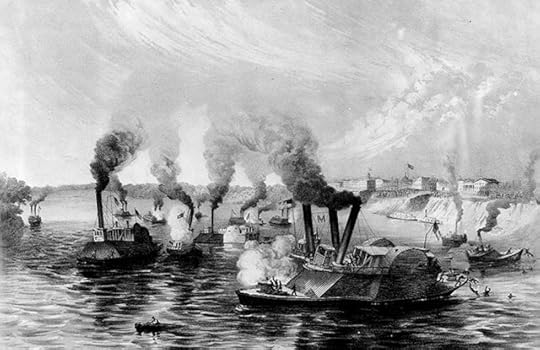 The Battle of Memphis showing the destruction of the Confederate river fleet under the command of James E. Montgomery. The citizens of Memphis had a front row seat watching from Chickasaw Bluff.
The Battle of Memphis showing the destruction of the Confederate river fleet under the command of James E. Montgomery. The citizens of Memphis had a front row seat watching from Chickasaw Bluff. While thus entangled in the crushed,broken, and sinking timbers of the Lovell, the Beauregard boredown and gave the Queen of the West a punch in her wheel which disabledit. But though disabled, she was not whipped and scorning to strike her colors,she nobly worked her way to the Arkansas shore with one wheel only and thereremained for the rest of the fight.
The other ram, the Monarch, hadworked her way as fast as possible after the Queen of the West nowarrived at the scene of the ramming. The Beauregard and Priceseeing her at hand, also made for her and the three rapidly near each other.The Monarch, anticipating their object and knowing that her best policywas to use a little sternway, reversed her engines and backed out from theblows intended for her by the two Rebel boats. The caused the Price and Beauregardto come together quite forcibly, the Beauregard striking the Pricea severe blow forward of the wheelhouse. While thus afoul of each other, the Monarchagain came forward and dealt the Beauregard a hard blow in her side. Atthe same time, the sharpshooters aboard the Monarch amused themselves bycoolly picking off the men engaged in working the enemy’s guns and succeeded inkilling numbers while driving the remainder inside their boats.
Our fire, which during this time hadalmost ceased by voluntary consent, now commenced with increased vigor and theenemy being closer to us than before, soon began to feel the effects of ourwell-directed shots. As you already know, the Price had been struck; shenow withdrew to the Arkansas shore and sank in shoal water. There remained the LittleRebel, Beauregard, Jeff Thompson, Sumter, General Bragg, and General VanDorn. The Beauregard, partially disabled by the Monarch,became unmanageable which we noticed and prepared to take advantage. We poureda destructive fire upon her and a lucky shell was not long in finding its wayto her boilers. Riddled with shots, her boilers blown up, and the crew disabledby rifle shots, shell fragments and the scalding steam. The ship was sinkingfrom the blow of the ram and what else could she do but haul down her flag orsink with it flying as all aboard perished. She preferred the former,humiliating as it was, and a white flag took its place.
"The Monarch, after sinking the Lovell, went in pursuit of the fleeing steamers Van Doran and Colonel Thompson at the foot of President’s Island. She overwhelmed the Thompson and brought her back, the Van Dorn making her escape. The Champion is now pumping out the General Price. She is a noble vessel and will be worth, when repaired, $150,000; the Sumter worth $75,000; the General Bragg worth $150,000, and the Little Rebel worth $10,000. Thus $385,000 has been captured in this battle, and an equal amount destroyed. Their whole fleet, except the Van Dorn, is gone and lost forever." ~ Chief Engineer William G. McFarland, U.S.S. Cincinnati
Having thus disposed of the Beauregard,we passed on as rapidly as possible after the others, leaving the poor wounded,scalded, and dying crew to be cared for by the rest of the fleet which followedus. Seeing the Little Rebel quite conspicuous, we gave her the benefitof a few shots, some of which pierced her side and caused her to be run to theArkansas shore and deserted by her crew. Jeff Thompson now appeareddisabled, whether from a ram or cannon shot I cannot say, but she also ran uponthe Arkansas shore and was deserted. Flames soon proceeded from her sides andabout 10 a.m., when we were returning victorious, she blew up her magazine. Theexplosion was very loud and the spectacle magnificent.
That left General Bragg, Sumter,and General Van Dorn, and they were making off as fast as possible. Ourshots, however, struck thick and fast around them and before they could get outof harm’s reach, all except the Van Dorn became disabled and fell intoour hands. The Bragg, as a consequence of getting a smash in her wheel,was deserted with her steam being first shut off. A few more moments and shewould have blown up her boilers. I have not learned how the Sumter becamedisabled or what damage she sustained; at any rate, she now lies anchored inthe stream, a few yards to the stern of us with the stars and stripes floatingat her masthead.
Beauregard suffered severely;she was both rammed and shot. The shots passed through her engines, knockingthe splinters in all directions and finally went through her boilers. Thesplinters struck and badly wounded the engineer; he is now on board and is in avery low condition. The steam from the boilers scalded four poor firemen in amost shocking manner. One who went on board immediately after the fight saysthe spectacle afforded by these sufferers exceeded anything he ever saw beforeand was enough to tear the most unfeeling heart. They implored him to give themrelief, but all the relief which could be afforded was produced by theapplication of flour, sprinkled very lightly upon them. So completely had thesteam penetrated the flesh that it hung in shreds upon their bones, the leasttouch or motion causing it to fall off entirely! As we passed her, she wassinking rapidly with steam escaping from all sides. I only saw one man aboardher; he sat on the stairs leading to the quarterdeck and forecastle begrimedwith powder and apparently wounded. He had lost his cap and his appearance wassad and heart-rending in the extreme.
We only had one man wounded. A pieceof exploding shell when the Jeff Thompson blew up struck a man aboardthe St. Louis, wounding him in the foot. Colonel Ellet commanding theram fleet was wounded in the leg by a pistol shot, not very badly, however. TheLittle Rebel received two shots in her starboard quarter but her crewescaped. Captain Coball of the General Lovell was shot through the headearly in the action by a rifle ball. The craft itself sank out of sightentirely. It is said that a man aboard the General Lovell was seen byone of our pilots rushing from the cabin out on to the deck with a pistol ineach hand crying, “the day is lost!” A moment afterward, he fell overboard andsank out of sight immediately. The river was filled with floating fragments ofspars, small boats, and bales of cotton. Men were struggling in the water inall directions and making frantic signs for assistance.
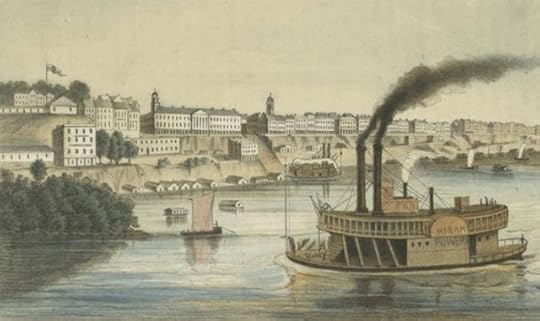 An antebellum view shows Memphis, Tennessee situated high atop Chickasaw Bluff overlooking the Mississippi River. The city was founded in 1819 and by the outbreak of the war was home to more than 22,000 residents, nearly a quarter of whom were Irish immigrants.
An antebellum view shows Memphis, Tennessee situated high atop Chickasaw Bluff overlooking the Mississippi River. The city was founded in 1819 and by the outbreak of the war was home to more than 22,000 residents, nearly a quarter of whom were Irish immigrants. As we approached the city afterdestroying part of the Rebel fleet and capturing the remainder, the bluffs werelined with an excited crowd of men, women, and children, comprising all thatwas left of the inhabitants of that city. Persons of all classes were there tobe seen from the noisy street boy to the quiet, sober, matter-of-fact man, andtheir countenances told as plain as any demonstration that they were disappointedand chagrined and that they wished we were on the bottom of the river in placeof the Confederates. I did not see an approving smile, nod, or salute from onein the crowd, but there may have been a very few which escaped my notice.
When we arrived about 50 yards fromthe landing, a skiff put out from shore and approached our boat. An old manstood in the stern and held aloft his handkerchief for a flag of truce. He wasconducted to the cabin where he remained some moments. He returned accompaniedby Captain Seth Ledyard Phelps, Lieutenant Bishop, and G.W. Reed.They then went to the post office building where, after a good deal of delay,they placed the stars and stripes. A good many indignities were offered by thelower class of society but no personal violence that I can learn.
The Confederate flag kept floatingfrom the flagstaff on the Square till 3:20 p.m. when a company of soldiers wentup and cut it down, pole and all. I hear the citizens declared it should nevercome down, but I think there is in this case a little exaggeration somewhere. Therewas a good deal of feeling manifested, however, so much so that we feared we wouldbe obliged to shell the city before it would come to terms. As soon as thebattle evidently turned in our favor, as many as the trains could carry leftthe city. The Memphis Appeal newspaper is now issued from Grenada,Mississippi.
Source:
Letters fromMoses Farnsworth, U.S.S. Benton, Weekly Waukegan Gazette (Illinois), June14, 1862, pg. 2; also, June 21, 1862, pg. 2
Daniel A. Masters's Blog
- Daniel A. Masters's profile
- 1 follower



